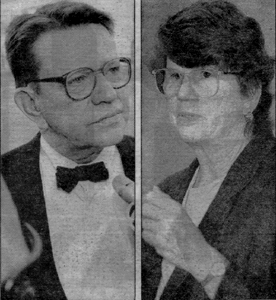

At one point 11 pieces of legislation aimed at curbing TV violence were on the table, including the Children's Protection from Violent Programming Act, introduced by Sen. Fritz Hollings (D-SC); The Markey Bill (Rep. Ed Markey, D-MA), which would force TV manufacturers t. Nancy Kassebaum (R-KS); Rep. Jim Slattery (D-KS) and Rep. John Bryant (D-TX). For their part, programmers seemed unwilling to agree with the premise that violence in society is caused by violence on television.
In August 1993, an articlet monitoring and regulation unless they become more socially responsible. President Clinton criticized Reno's endorsement of the bills, saying he did not want her office to trample First Amendment rights.
By January 1994, the spin doctors in Simon's office were working overtime on a report thatBS and NBC. Simon's sudden loss of bluster may have had something to do with the decision of a federal appeals court in Washington a month earlier. The court struck down Federal Communications Commission rules banning the broadcast of so-called "indecent" material during most broadcast hours.
.I" and "Hawaii Five-O." And the network honchos further argue that they regularly take a pass on showing movies that will inevitably be picked up by independent and cable outlets, which will then beat the networks in the ratings.
In October 1993, Attorney General Janet Reno told lawmakers that she feels the regulation of violence is constitutionally permissible, and threatened programmers with Government monitoring and regulation unless they become more socially responsible. President Clinton criticized Reno's endorsement of the bills, saying he did not want her office to trample First Amendment rights.
By January 1994, the spin doctors in Simon's office were working overtime on a report that Simon was "moving away" from the idea of legislation against television violence following "positive and constructive" meetings with the heads of Showtime, HBO, ABC, CBS and NBC. Simon's sudden loss of bluster may have had something to do with the decision of a federal appeals court in Washington a month earlier. The court struck down Federal Communications Commission rules banning the broadcast of so-called "indecent" material during most broadcast hours.
Source: Chicago Sun-Times, Chicago Tribune (various dates)